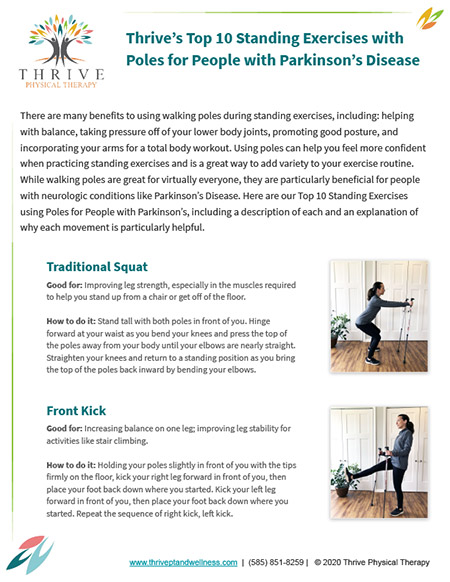If you or your loved one experiences freezing episodes due to Parkinson’s Disease, you’ve probably said or heard something like these:
It feels like my feet are glued to the floor.
My whole body is frozen in place.
I take these little stutter steps and can’t move forward.
I can’t get started walking.
It’s like there are magnets under my feet.
If I’m nervous, I walk on my tip toes and the walker gets away from me.

There’s a lot to know about Freezing. Read on to learn about it.
Why it’s a problem:
Freezing is a very frustrating symptom of PD and can cause people to feel self-conscious and anxious about movement. This results in avoiding activity and movement, which unfortunately perpetuates the freezing tendencies even further.
Freezing also contributes to a person having a higher risk of falling and can significantly limit them from participating in meaningful activities due to a fear of “getting stuck.” And while some people with Parkinson’s never experience Freezing, it is estimated that approximately 80% of people with PD will develop challenges associated with Freezing.
Types of Freezing:
People may experience Freezing with speech, hand movements, or while moving about in daily life during activities like moving in bed, getting up from a chair, and most commonly–while walking. When freezing happens while walking, it is known as “Freezing of Gait,” often abbreviated as FOG. Because FOG is the most common type of Freezing that we see with our patients at Thrive, let’s take a deeper look at what’s going on when it happens.

Why it happens:
Just like Parkinson’s disease is very complex and everyone’s experience with it is different, the symptom of Freezing is also quite complicated and varied. There are various theories to pinpoint exactly what is happening in your brain circuitry that causes Freezing, however, we still do not completely understand why some people with PD freeze and others don’t.
At a basic level, we do know that Freezing happens because there are disruptions of the brain networks and communication pathways that have to coordinate together in order for us to start moving and to continue to move smoothly and automatically.
For many people, non-motor symptoms of Parkinson’s, like cognitive changes, anxiety, and visual-perceptual changes also influence Freezing characteristics. We also understand that the longer a person has had Parkinson’s, the more they are at risk of developing Freezing. Researchers are also exploring the relationship between REM Sleep Behavior Disorder and Freezing of gait since there is a significant overlap between the brain structures that are affected.
What are freezing triggers?
Many people tell us that they can walk OK in a straight pathway, but freeze when something in the environment changes. These changes are known as Freezing triggers. For many people, they may include:
- Turning a corner
- Going through a narrow space
- Navigating a crowded space
- Going through doorways
- Doing two things at once, such as someone coming alongside of them and initiating a conversation
- Approaching a chair
Some people also experience something called “start hesitation,” which means there is a delay when they try to initiate movement. This happens BEFORE a person even takes their first step. For most people, this is a momentary paralysis of movement that they overcome in 1-2 seconds.
We also know that freezing becomes worse when a person feels stressed out or are rushing.
What can be done about it?
- Optimize your Medications: Adjustments to your Parkinson’s medication(s) can help, so the first step is to speak to your neurologist about your Freezing experiences to make sure your medication doses and timing are prescribed as they see fit. And while Parkinson’s medications can help Freezing, this is only part of the solution.
- Physical Therapy: Physical therapists who specialize in Parkinson’s disease are trained to evaluate Freezing of gait to prescribe the correct exercises and strategies to help you move your best. In addition to the underlying brain changes from Parkinson’s disease, many people who freeze also have muscle imbalances including posture changes, tightness in the front of their hips, and very stiff ankles which makes Freezing even worse. Your Parkinson’s physical therapist will be able to put together all the pieces of this complicated puzzle and tailor an individualized approach to help you overcome your freezing challenges. In addition to using external cues such as the metronome and visual targets (lasers, tape), we also implement many rehabilitative strategies including practicing high amplitude stepping, and teaching turning techniques. We have seen tremendous success in treating freezing of gait in people with Parkinson’s at Thrive Physical Therapy!
- Tricks: Lots of people overcome Freezing by using tricks that change their thoughts during a freeze and reroute the brain to use a different, unstuck pathway. This strategy activates the conscious part of the brain to substitute for the malfunctioning automatic part of the brain.
Some tricks people use include:
- Humming or whistling their favorite song
- Bending their knees up and down or marching
- Visualizing themselves
- Taking a step backwards
- Counting aloud to 3
- Touching a body part
- The 5S Method
The 5S Method is a sequence of 5 tips/tricks to help “thaw” a freeze. It can be extremely helpful once you learn and practice it.
The 5S Method consists of the following 5 sequential steps:
- STOP: Fighting the feeling of being stuck will make it worse. Stop where you are.
- STAND TALL: Squeeze your shoulder blades back and “Power Up” your posture.
- SIGH: Relax your body. Take a deep breath and sigh it out. Shake your hands to loosen them up.
- SHIFT YOUR WEIGHT: Widen your feet on the floor and shift your weight side to side.
- STEP BIG: Take a giant step forward and walk like you are on a mission!
Download our 5S Cheat Sheet to print and post on your refrigerator!
If you are a Thrive patient, be sure to ask your therapist for your 5S magnet if you don’t already have one.

In Summary:
Freezing can be a very challenging symptom of Parkinson’s but through adjustments to your medications (by your neurologist), seeing a Parkinson’s specialized physical therapist, and applying tricks that you find helpful, Freezing can be greatly reduced. Please share any tips or strategies that you have found helpful in the comments section below!







